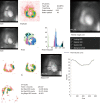Equilibrium radionuclide angiocardiography: Its usefulness in current practice and potential future applications
- PMID: 23150766
- PMCID: PMC3495989
- DOI: 10.4329/wjr.v4.i10.421
Equilibrium radionuclide angiocardiography: Its usefulness in current practice and potential future applications
Abstract
The routine and potential future applications of equilibrium radionuclide angiocardiography/multigated acquisition (MUGA) in clinical decision making are explored in this review. The non-invasive nature of the test, less operator dependence, lower radiation dose and ease of performing, even in ill patients, are important considerations in clinical cardiology practice. Two important routine uses of this modality in day-to-day clinical practice include the following: serial assessment of left ventricular ejection fraction (LVEF) in patients receiving cardiotoxic chemotherapy, and determination of accurate LVEF in patients with intractable heart failure. Other potential utilities of MUGA that could be translated into clinical practice include determination of regional LVEF, obtaining information about both right and left ventricle in suitable patients as a part of first pass angiocardiography, identification of diastolic dysfunction in patients with heart failure with preserved LVEF, and demonstration of dyssynchrony prior to cardiac resynchronisation, specifically by MUGA single photon emission tomography.The last two indications are particularly important and evolving at this point.
Keywords: Angiocardiography; Diastolic parameters; Dyssynchrony; Equilibrium radionuclide; Left ventricular ejection fraction; Multigated acquisition.
Figures




Similar articles
-
[Right and left ventricular ejection fraction evaluation in patients with chronic pulmonary disease. Comparison of nuclear medicine methods].Hell J Nucl Med. 2005 Sep-Dec;8(3):191-9. Hell J Nucl Med. 2005. PMID: 16390031 Clinical Trial. Greek, Modern.
-
Ventricular ejection fraction in patients with dilated cardiomyopathy calculated by gated blood pool SPET processing software: correlation with multigated acquisition and first pass radionuclide ventriculography.Hell J Nucl Med. 2011 Sep-Dec;14(3):234-8. Hell J Nucl Med. 2011. PMID: 22087441
-
Clinical validation of the gated blood pool SPECT QBS processing software in congestive heart failure patients: correlation with MUGA, first-pass RNV and 2D-echocardiography.Int J Cardiovasc Imaging. 2006 Jun-Aug;22(3-4):407-16. doi: 10.1007/s10554-005-9031-1. Epub 2005 Nov 22. Int J Cardiovasc Imaging. 2006. PMID: 16328851
-
Impact of physiologic pacing versus right ventricular pacing among patients with left ventricular ejection fraction greater than 35%: A systematic review for the 2018 ACC/AHA/HRS guideline on the evaluation and management of patients with bradycardia and cardiac conduction delay: A Report of the American College of Cardiology/American Heart Association Task Force on Clinical Practice Guidelines and the Heart Rhythm Society.Heart Rhythm. 2019 Sep;16(9):e280-e298. doi: 10.1016/j.hrthm.2018.10.035. Epub 2018 Nov 6. Heart Rhythm. 2019. PMID: 30412776
-
Review of tests for monitoring doxorubicin-induced cardiomyopathy.Oncology. 1996 Nov-Dec;53(6):461-70. doi: 10.1159/000227621. Oncology. 1996. PMID: 8960141 Review.
Cited by
-
Shining Damaged Hearts: Immunotherapy-Related Cardiotoxicity in the Spotlight of Nuclear Cardiology.Int J Mol Sci. 2022 Mar 30;23(7):3802. doi: 10.3390/ijms23073802. Int J Mol Sci. 2022. PMID: 35409161 Free PMC article. Review.
-
Nuclear imaging for cardiac amyloidosis.Heart Fail Rev. 2015 Mar;20(2):145-54. doi: 10.1007/s10741-014-9463-6. Heart Fail Rev. 2015. PMID: 25424887 Review.
-
Pre-chemotherapy values for left and right ventricular volumes and ejection fraction by gated tomographic radionuclide angiography using a cadmium-zinc-telluride detector gamma camera.J Nucl Cardiol. 2016 Feb;23(1):87-97. doi: 10.1007/s12350-015-0177-5. Epub 2015 Sep 4. J Nucl Cardiol. 2016. PMID: 26338424
-
Society for Immunotherapy of Cancer (SITC) clinical practice guideline on immune effector cell-related adverse events.J Immunother Cancer. 2020 Dec;8(2):e001511. doi: 10.1136/jitc-2020-001511. J Immunother Cancer. 2020. PMID: 33335028 Free PMC article.
-
Up-titration of medication in patients with new-onset heart failure with and without atrial fibrillation.ESC Heart Fail. 2025 Jun;12(3):1703-1713. doi: 10.1002/ehf2.15188. Epub 2025 Feb 19. ESC Heart Fail. 2025. PMID: 39968941 Free PMC article.
References
-
- van Royen N, Jaffe CC, Krumholz HM, Johnson KM, Lynch PJ, Natale D, Atkinson P, Deman P, Wackers FJ. Comparison and reproducibility of visual echocardiographic and quantitative radionuclide left ventricular ejection fractions. Am J Cardiol. 1996;77:843–850. - PubMed
-
- Nousiainen T, Vanninen E, Jantunen E, Puustinen J, Remes J, Rantala A, Hartikainen J. Comparison of echocardiography and radionuclide ventriculography in the follow-up of left ventricular systolic function in adult lymphoma patients during doxorubicin therapy. J Intern Med. 2001;249:297–303. - PubMed
-
- Corbett JR, Akinboboye OO, Bacharach SL, Borer JS, Botvinick EH, DePuey GE, Ficaro EP, Hansen CL, Henzlova MJ, Van Kriekinge S. ASNC imaging guidelines for nuclear cardiology procedure. Equilibrium radionuclide angiocardiography. USA: Amer Soc Nucl Card; 2008. - PubMed
-
- Murphy P, Port S. Radionuclide evaluation of left ventricular function. In: Sandler M, Coleman R, Patton J, Wackers F, Gottschalk A, et al., editors. Diagnostic Nuclear Medicine, 4th ed. Philadelphia: Lippincott Williams and Winkins; 2003. pp. 239–271.
-
- Gill JB, Moore RH, Tamaki N, Miller DD, Barlai-Kovach M, Yasuda T, Boucher CA, Strauss HW. Multigated blood-pool tomography: new method for the assessment of left ventricular function. J Nucl Med. 1986;27:1916–1924. - PubMed
LinkOut - more resources
Full Text Sources

